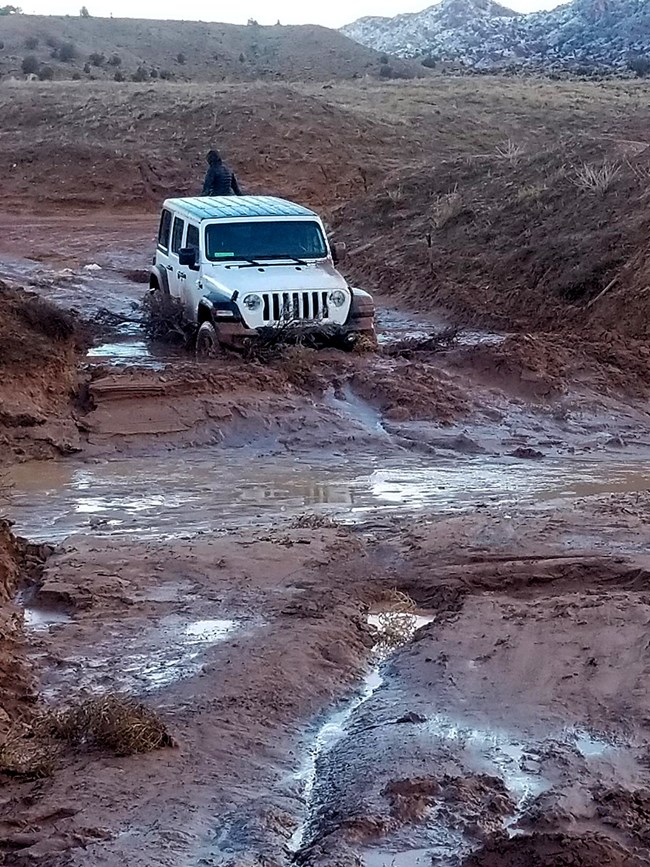
NPS - J. Axel
Parashant is a scenic wonder, but it also is one of the last truly remote places in the United States. A visit here means leaving the safety net of the modern world behind. The information that follows is not designed to scare potential visitors out of visiting the monument but remind everyone that traveling into Parashant isn't to be taken lightly. Rangers want to be sure motorists understand that travel here requires specialized vehicles, equipment, and planning to avoid or recover from a mishap. The fact that you are reading this means you are the right track as you prepare for a safer visit to the monument. Thank you! Please contact us at the number on the bottom of the page if you would like to discuss with a ranger your equipment, skill level, and trip plans. You are responsible for your own safety and you must be able to self-rescue. Appropriate vehicles and equipment in good working order and adequate supplies are critical. Roads are narrow and winding. Travelers need to be prepared for their trip and understand the guidance below. All roads are unpaved and of varying difficulty. While not prohibited, cars, minivans, crossover SUVs, and RVs are not the right vehicles for travel in this monument. A high clearance 4x4 with tires designed for off-pavement use is the most important safety item you need. Most rescues involve vehicles with multiple flats where rocks ripped up tires only rated for street use. Other reasons include vehicles getting stuck in mud or high-centered on uneven road beds, or vehicles suffering some kind of mechanical breakdown. Scroll to the bottom of the page for definitions of terms like "All-Terrain" tires, the difference between a "high clearance" and "very high clearance" 4x4, and what a "short wheelbase" is. Recommended Equipment and Supplies:

NPS - J. Axel 
NPS - J. Axel
Road Conditions

NPS - J. Axel All-Terrain/Mud Terrain Tires: For full size vehicles the ideal tire is a good condition E-Range All-Terrain tire.This is a tire that has a very thick rubber tread, more flexible rubber, and much stronger steel belts inside the rubber to handle driving over rocks. Load range E is equivalent to a 10-ply tire, where there are 10 layers of reinforcement in the tire. Load Range D tires are equivalent to 8-ply tread, and C is equivalent to 6-ply tread. You also want 3-ply sidewalls on your tires as the rougher roads have rocks along them that will rip open thin sidewalls. Mud-terrain tires are not effective at handling mud on the Arizona Strip. The local clay packs into the spaces between the knobby treads like peanut butter. It isn't flung out by the revolution of the wheel like watery mud in other regions of the country. Mud-terrain tires turn into slick, smooth donuts that have no traction in mud in this area. Rugged Spare Tires: If you plan to spend a lot of time on unpaved roads, your vehicle needs at least one All-Terrain spare tire. Most stock spare tires are thin and will blow out after only a few miles on a rocky road. Do you need 2 spare tires? Motorists occasionally scrape and rupture the sidewall of a front tire against a rock along the road. Then before they realize what happened they also rip open the sidewall on the rear tire on the same rock. This has caused many double flats. Street Tires: These are normal automobile tires. They are designed for pavement only. Their rubber is thinner than all-terrain tires. The rubber is stiffer, and often equivalent to 4-ply tread with 1-ply sidewalls. Street tires may ride more comfortably on pavement and last longer, but they are far more likely to rupture off-pavement. Rental 4x4 Warning: Rental 4x4 trucks and SUVs often come with street tires not designed for off-pavement use. Just because the vehicle is a 4x4 doesn't mean it has the right tires. Check the sidewall to see if it says "All-Terrain." Tire Pressure: Many new vehicles including pickups come with tire pressures up to 75 pounds per square inch. This is very high pressure. Many off-road motorists lower their tire pressure to well under 40psi when traveling on rough roads, then fill the tire back to recommended pressure when they return to pavement. The risk with highly pressurized tires on unpaved roads is blowouts. As tires go over rocks, they are so rigid from the high pressure they can't flex and absorb rocky surfaces, so instead they rupture. What is the difference between a 4x4 and All Wheel Drive (AWD) vehicle? True 4x4 vehicles have a 'transfer case' in the drive-train that puts full engine power to the front wheels. All Wheel Drive (AWD), common on vehicles like crossover SUVs, relies on a 'differential' to send variable power to each wheel. AWD is good on level roadbeds in low traction conditions like snow. It is not designed to fully power the front tires in off-pavement rugged situations. For example, if the road goes up a steep hill and there is a lot of loose rock in the road, fully powered front wheels are needed to rotate strongly and pull the vehicle up the slope. AWD cannot do that very well and may fail. Very High Clearance: Factory vehicles that look like the icon to the left, or UTV/side-by-sides are considered very high clearance. Also included are 4x4s with aftermarket suspension lifts and taller tires. Low Clearance: Any car, minivan, or RV, and many SUV 'crossover' vehicles. None of these are designed for Parashant's roads, even with off-pavement tires as they sit low to the ground and can scrape off plastic trim or engine components like the oil pan. Short Wheelbase: These are vehicles where the front and rear axles are closer together, as well as 4x4 pickup trucks with a short bed (less than 6' long) and a regular cab. Short wheelbase vehicles create a situation where the rear tires start to climb a hump in the road, or obstacle before the front tires go down the other side. This lifts the center of the vehicle up and over the hump, preventing scraping. Long Wheelbase: These are vehicles where the front and rear axles are further apart. This includes longer SUVs designed for 7-9 passengers or 4x4 pickups with a crew cab and/or long bed (see image of red truck below). Long wheelbase vehicles create a situation where the rear tires haven't yet reached the hump in the road but the front tires have already cleared the hump. The vehicle can high center and get stuck. Entry/Departure Angle: Short wheelbase vehicles simply are shorter, making getting through a wash easy. Long wheelbase vehicles may be too long and hang up on the front or rear bumper. Bumpers: If you have a stock front bumper look at how close the bumper is to the ground. On rough 4x4 roads, hazards like boulders, deep ruts, or hard centerline ridges in the road can rip off the bumper. Vehicles designed for rugged off-pavement use have had the lowest parts of the front bumper's air dam removed, or a custom bumper installed that is much higher off the ground. If you drive into a wash at a steep downward angle that suddenly pitches up to leave the wash, this scrapes the bumper against the roadbed, which will scrape and damage the bumper. Running Bars/Step Bars: Like low bumpers, these bars along the vehicle are used to step easily into a truck or SUV. They reduce clearance and can be damaged or ripped off on rough roads. However, they can also absorb most of an impact and protect the vehicle's body and doors. 
NPS - J. Axel 
BLM From December through March each year rain and snow make roads above 4,000 feet elevation mostly impassable. This includes areas like Mt. Trumbull, Mt. Logan, Mt. Dellenbaugh, and Twin Point. These roads may only be passable by high clearance 4x4 vehicles when frozen, usually at night or early morning. The ice melts during the day and motorists will get stuck or slide off the road unless they wait for it to freeze again. Many of these roads are seldom traveled so stranded motorists may not see another vehicle for days or longer. This means there won't be someone ''coming by" to rescue them. This can create a life-or-death situation due to cold temperatures and remoteness. At this time of year rangers recommend that the public explore the western section of the monument like Pakoon Springs. That area is in the low desert where roads are rocky/sandy instead of muddy and winter temperatures are usually mild during the day. |
Last updated: June 9, 2025



